Long TOYOTA BZ4X 2022 (in English) Workshop Manual
[x] Cancel search | Manufacturer: TOYOTA, Model Year: 2022, Model line: BZ4X, Model: TOYOTA BZ4X 2022Pages: 674, PDF Size: 120.02 MB
Page 342 of 674
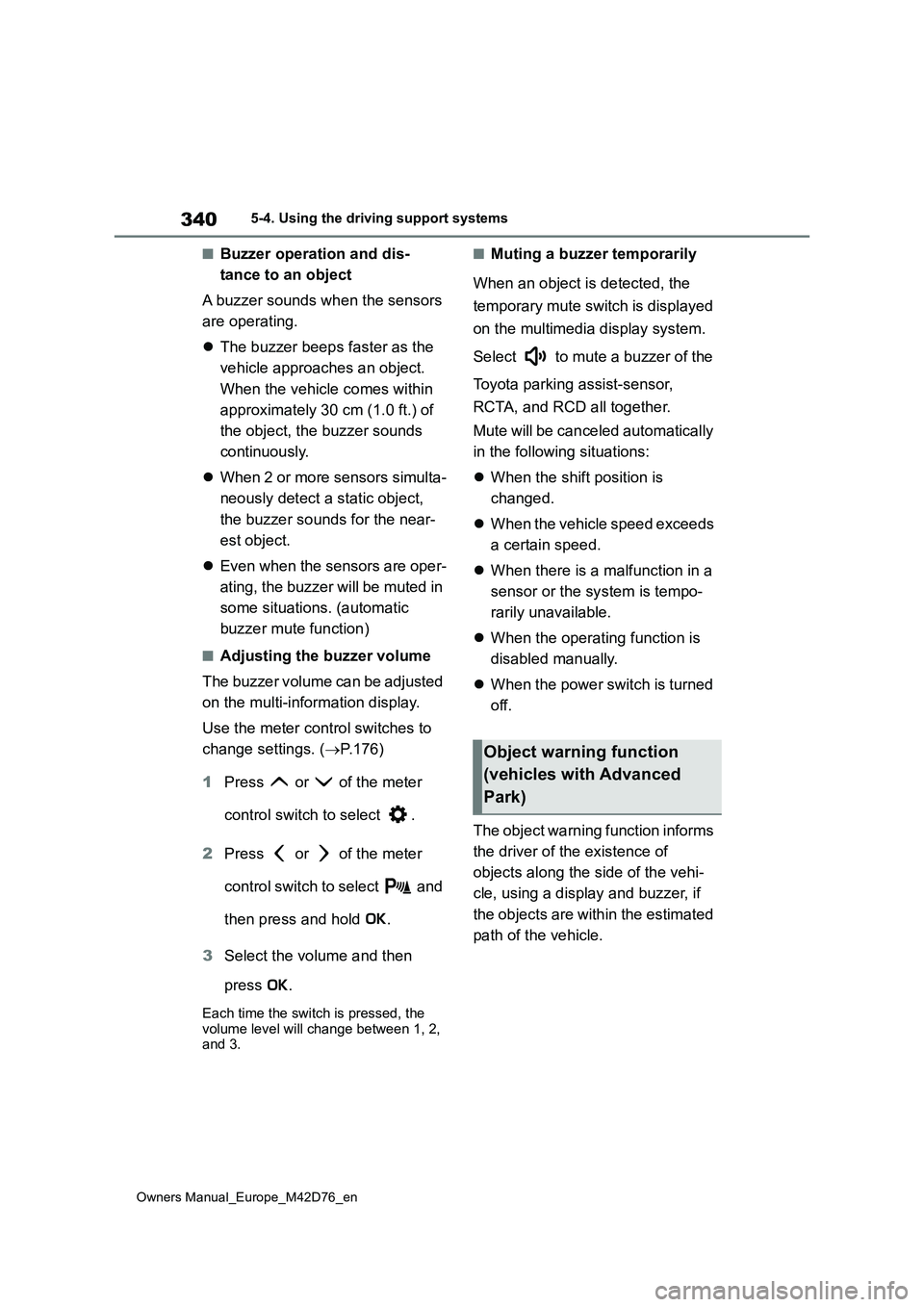
340
Owners Manual_Europe_M42D76_en
5-4. Using the driving support systems
■Buzzer operation and dis-
tance to an object
A buzzer sounds when the sensors
are operating.
The buzzer beeps faster as the
vehicle approaches an object.
When the vehicle comes within
approximately 30 cm (1.0 ft.) of
the object, the buzzer sounds
continuously.
When 2 or more sensors simulta-
neously detect a static object,
the buzzer sounds for the near-
est object.
Even when the sensors are oper-
ating, the buzzer will be muted in
some situations. (automatic
buzzer mute function)
■Adjusting the buzzer volume
The buzzer volume can be adjusted
on the multi-information display.
Use the meter control switches to
change settings. ( P.176)
1 Press or of the meter
control switch to select .
2 Press or of the meter
control switch to select and
then press and hold .
3 Select the volume and then
press .
Each time the switch is pressed, the volume level will change between 1, 2, and 3.
■Muting a buzzer temporarily
When an object is detected, the
temporary mute switch is displayed
on the multimedia display system.
Select to mute a buzzer of the
Toyota parking assist-sensor,
RCTA, and RCD all together.
Mute will be canceled automatically
in the following situations:
When the shift position is
changed.
When the vehicle speed exceeds
a certain speed.
When there is a malfunction in a
sensor or the system is tempo-
rarily unavailable.
When the operating function is
disabled manually.
When the power switch is turned
off.
The object warning function informs
the driver of the existence of
objects along the side of the vehi-
cle, using a display and buzzer, if
the objects are within the estimated
path of the vehicle.
Object warning function
(vehicles with Advanced
Park)
Page 343 of 674
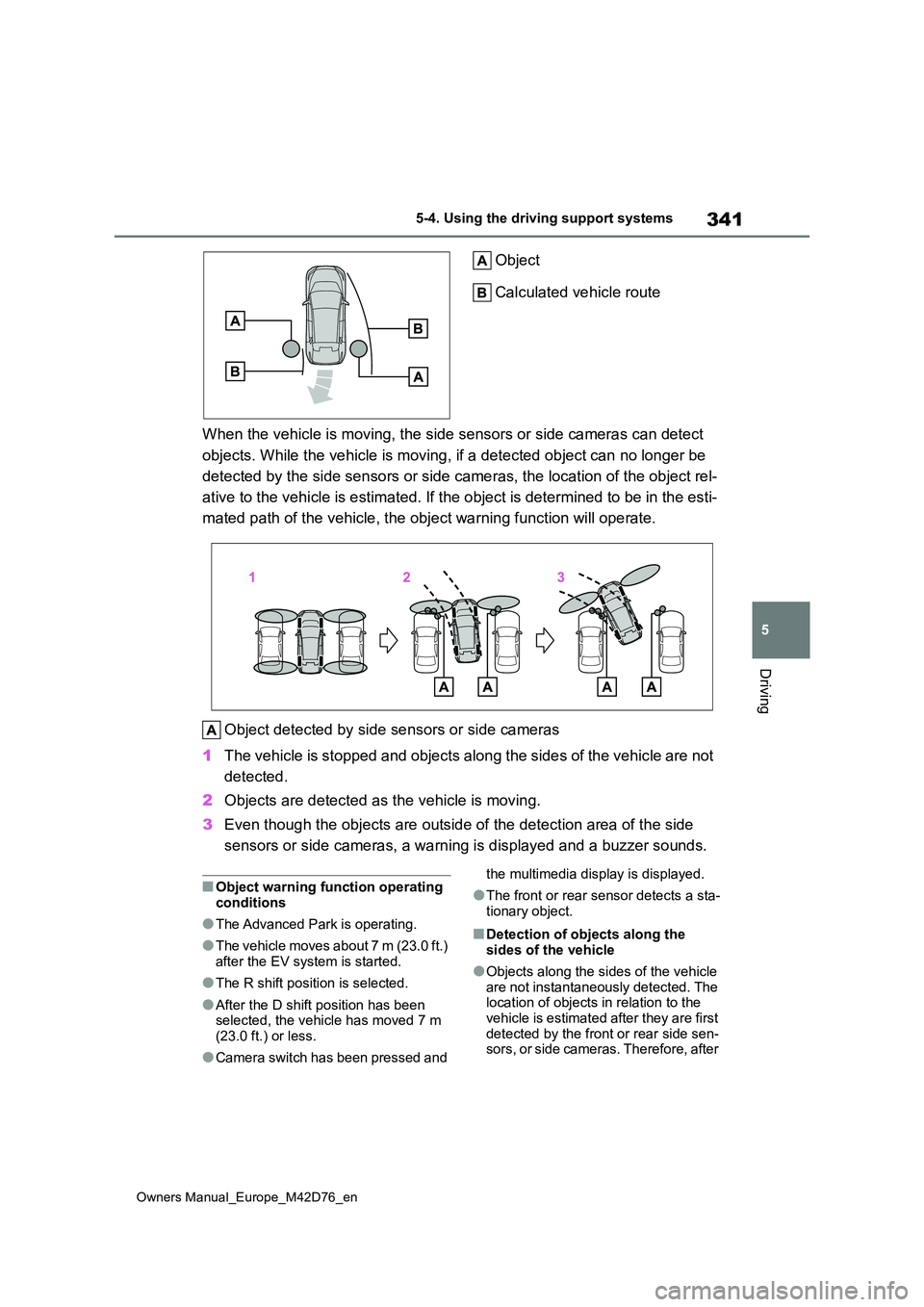
341
5
Owners Manual_Europe_M42D76_en
5-4. Using the driving support systems
Driving
Object
Calculated vehicle route
When the vehicle is moving, the side sensors or side cameras ca n detect
objects. While the vehicle is moving, if a detected object can no longer be
detected by the side sensors or side cameras, the location of t he object rel-
ative to the vehicle is estimated. If the object is determined to be in the esti-
mated path of the vehicle, the object warning function will ope rate.
Object detected by side sensors or side cameras
1 The vehicle is stopped and objects along the sides of the vehicle are not
detected.
2 Objects are detected as the vehicle is moving.
3 Even though the objects are outside of the detection area of the side
sensors or side cameras, a warning is displayed and a buzzer so unds.
■Object warning function operating conditions
●The Advanced Park is operating.
●The vehicle moves about 7 m (23.0 ft.)
after the EV system is started.
●The R shift position is selected.
●After the D shift position has been selected, the vehicle has moved 7 m
(23.0 ft.) or less.
●Camera switch has been pressed and
the multimedia display is displayed.
●The front or rear sensor detects a sta-
tionary object.
■Detection of objects along the sides of the vehicle
●Objects along the sides of the vehicle are not instantaneously detected. The location of objects in relation to the
vehicle is estimated after they are first detected by the front or rear side sen-sors, or side cameras. Therefore, after
Page 344 of 674
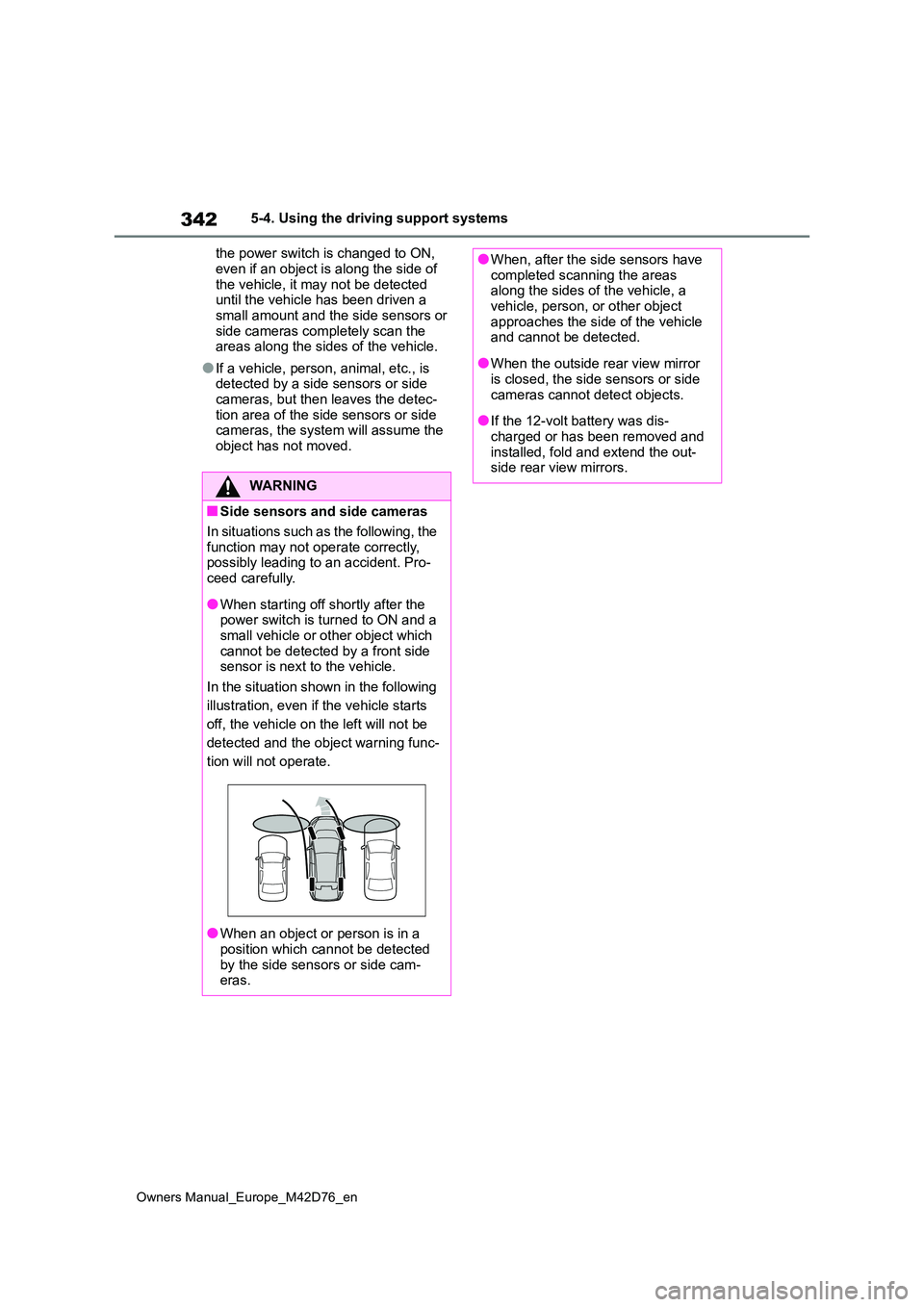
342
Owners Manual_Europe_M42D76_en
5-4. Using the driving support systems
the power switch is changed to ON,
even if an object is along the side of the vehicle, it may not be detected until the vehicle has been driven a
small amount and the side sensors or side cameras completely scan the areas along the sides of the vehicle.
●If a vehicle, person, animal, etc., is detected by a side sensors or side
cameras, but then leaves the detec- tion area of the side sensors or side cameras, the system will assume the
object has not moved.
WARNING
■Side sensors and side cameras
In situations such as the following, the
function may not operate correctly, possibly leading to an accident. Pro-ceed carefully.
●When starting off shortly after the power switch is turned to ON and a
small vehicle or other object which cannot be detected by a front side sensor is next to the vehicle.
In the situation shown in the following
illustration, even if the vehicle starts
off, the vehicle on the left will not be
detected and the object warning func-
tion will not operate.
●When an object or person is in a position which cannot be detected
by the side sensors or side cam- eras.
●When, after the side sensors have completed scanning the areas along the sides of the vehicle, a
vehicle, person, or other object approaches the side of the vehicle and cannot be detected.
●When the outside rear view mirror is closed, the side sensors or side
cameras cannot detect objects.
●If the 12-volt battery was dis-
charged or has been removed and installed, fold and extend the out-side rear view mirrors.
Page 353 of 674
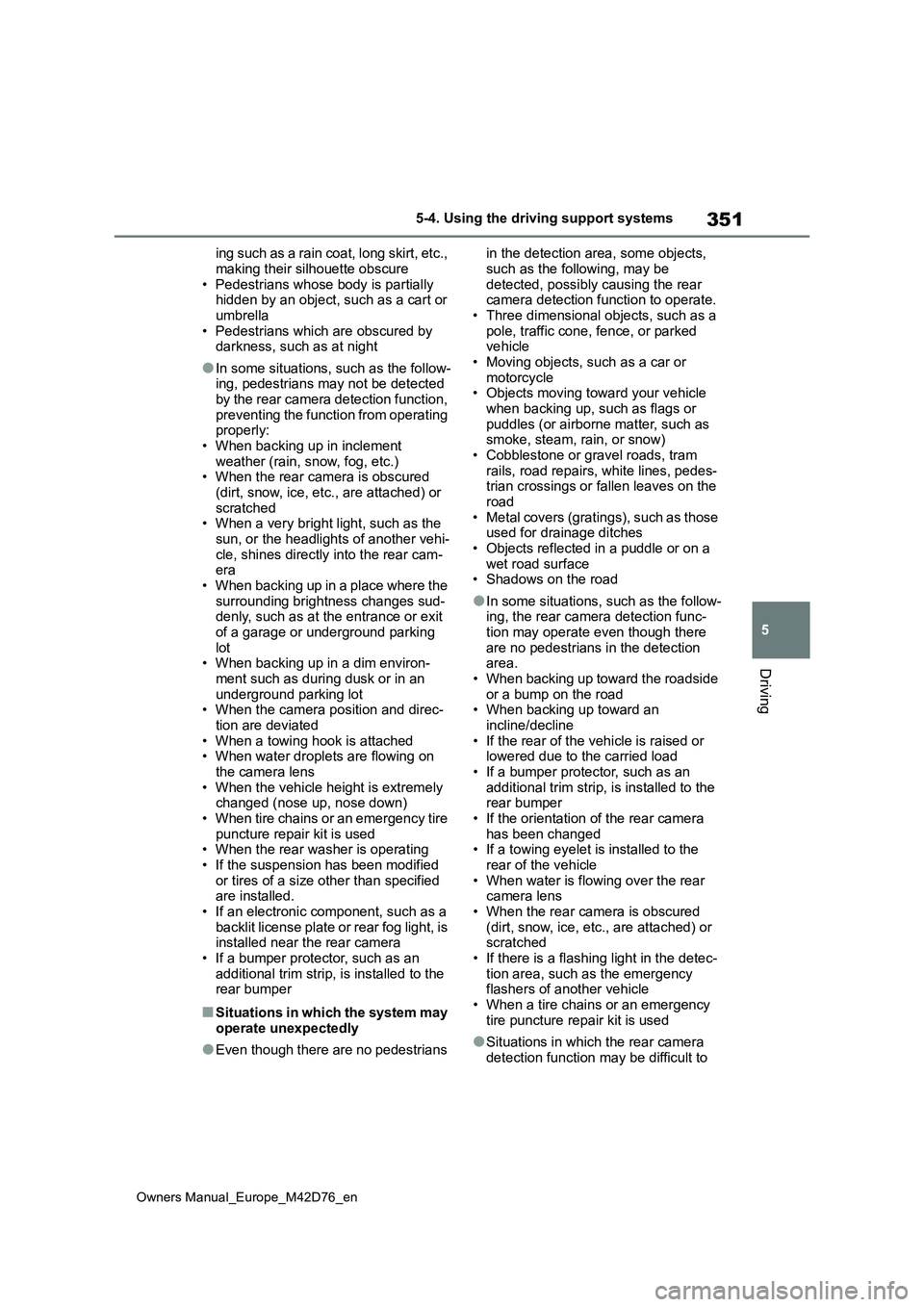
351
5
Owners Manual_Europe_M42D76_en
5-4. Using the driving support systems
Driving
ing such as a rain coat, long skirt, etc.,
making their silhouette obscure • Pedestrians whose body is partially hidden by an object, such as a cart or
umbrella • Pedestrians which are obscured by darkness, such as at night
●In some situations, such as the follow-ing, pedestrians may not be detected
by the rear camera detection function, preventing the function from operating properly:
• When backing up in inclement weather (rain, snow, fog, etc.)• When the rear camera is obscured
(dirt, snow, ice, etc., are attached) or scratched• When a very bright light, such as the
sun, or the headlights of another vehi- cle, shines directly into the rear cam-era
• When backing up in a place where the surrounding brightness changes sud-denly, such as at the entrance or exit
of a garage or underground parking lot• When backing up in a dim environ-
ment such as during dusk or in an underground parking lot• When the camera position and direc-
tion are deviated • When a towing hook is attached• When water droplets are flowing on
the camera lens • When the vehicle height is extremely changed (nose up, nose down)
• When tire chains or an emergency tire puncture repair kit is used• When the rear washer is operating
• If the suspension has been modified or tires of a size other than specified are installed.
• If an electronic component, such as a backlit license plate or rear fog light, is installed near the rear camera
• If a bumper protector, such as an additional trim strip, is installed to the rear bumper
■Situations in which the system may
operate unexpectedly
●Even though there are no pedestrians
in the detection area, some objects,
such as the following, may be detected, possibly causing the rear camera detection function to operate.
• Three dimensional objects, such as a pole, traffic cone, fence, or parked vehicle
• Moving objects, such as a car or motorcycle• Objects moving toward your vehicle
when backing up, such as flags or puddles (or airborne matter, such as smoke, steam, rain, or snow)
• Cobblestone or gravel roads, tram rails, road repairs, white lines, pedes-trian crossings or fallen leaves on the
road • Metal covers (gratings), such as those used for drainage ditches
• Objects reflected in a puddle or on a wet road surface• Shadows on the road
●In some situations, such as the follow-ing, the rear camera detection func-
tion may operate even though there are no pedestrians in the detection area.
• When backing up toward the roadside or a bump on the road• When backing up toward an
incline/decline • If the rear of the vehicle is raised or lowered due to the carried load
• If a bumper protector, such as an additional trim strip, is installed to the rear bumper
• If the orientation of the rear camera has been changed• If a towing eyelet is installed to the
rear of the vehicle • When water is flowing over the rear camera lens
• When the rear camera is obscured (dirt, snow, ice, etc., are attached) or scratched
• If there is a flashing light in the detec- tion area, such as the emergency flashers of another vehicle
• When a tire chains or an emergency tire puncture repair kit is used
●Situations in which the rear camera detection function may be difficult to
Page 358 of 674
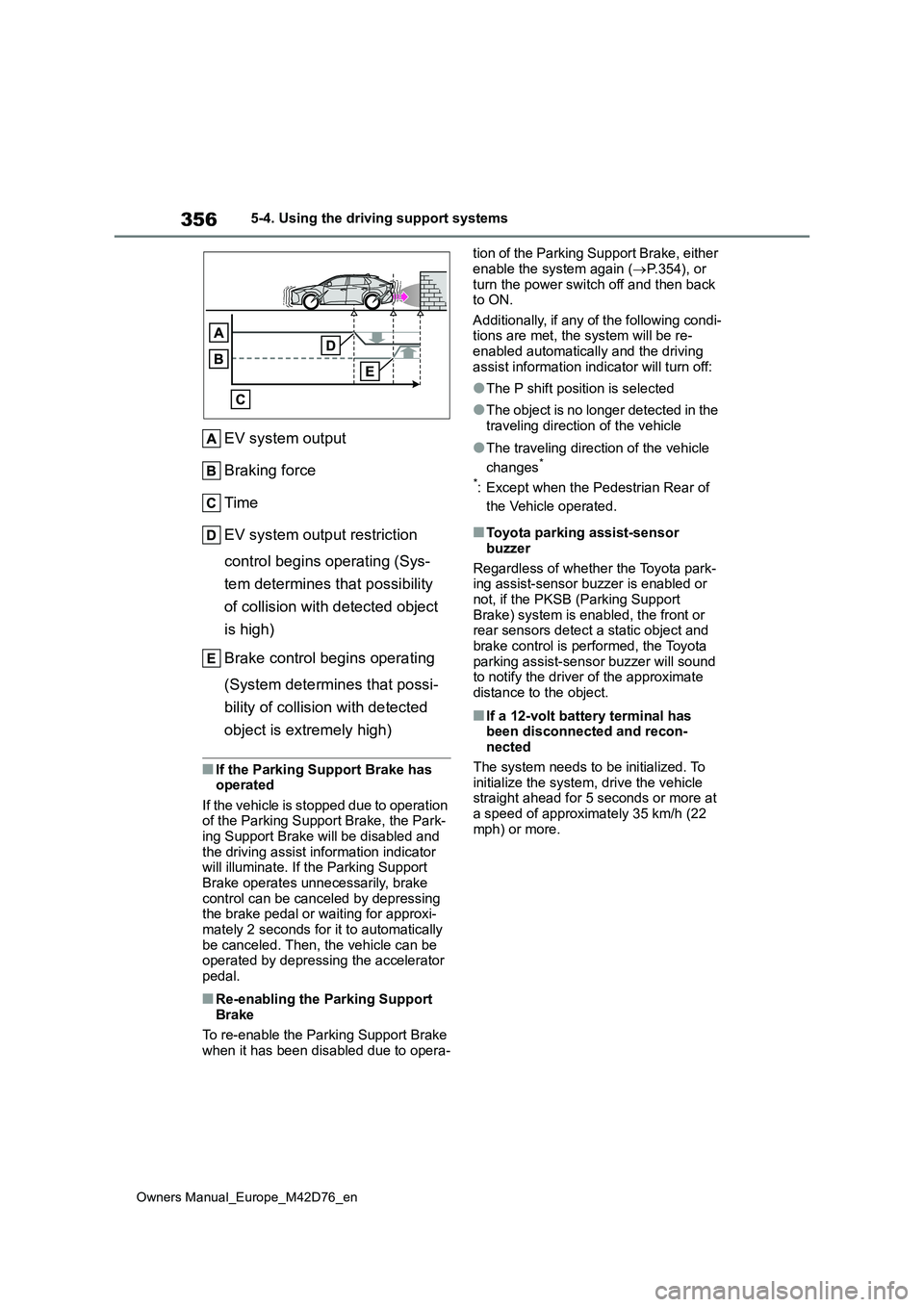
356
Owners Manual_Europe_M42D76_en
5-4. Using the driving support systems
EV system output
Braking force
Time
EV system output restriction
control begins operating (Sys-
tem determines that possibility
of collision with detected object
is high)
Brake control begins operating
(System determines that possi-
bility of collision with detected
object is extremely high)
■If the Parking Support Brake has operated
If the vehicle is stopped due to operation of the Parking Support Brake, the Park-ing Support Brake will be disabled and
the driving assist information indicator will illuminate. If the Parking Support Brake operates unnecessarily, brake
control can be canceled by depressing the brake pedal or waiting for approxi-mately 2 seconds for it to automatically
be canceled. Then, the vehicle can be operated by depressing the accelerator pedal.
■Re-enabling the Parking Support
Brake
To re-enable the Parking Support Brake when it has been disabled due to opera-
tion of the Parking Support Brake, either
enable the system again ( P.354), or turn the power switch off and then back to ON.
Additionally, if any of the following condi- tions are met, the system will be re-enabled automatically and the driving
assist information indicator will turn off:
●The P shift position is selected
●The object is no longer detected in the traveling direction of the vehicle
●The traveling direction of the vehicle
changes*
*: Except when the Pedestrian Rear of
the Vehicle operated.
■Toyota parking assist-sensor
buzzer
Regardless of whether the Toyota park- ing assist-sensor buzzer is enabled or
not, if the PKSB (Parking Support Brake) system is enabled, the front or rear sensors detect a static object and
brake control is performed, the Toyota parking assist-sensor buzzer will sound to notify the driver of the approximate
distance to the object.
■If a 12-volt battery terminal has been disconnected and recon-nected
The system needs to be initialized. To initialize the system, drive the vehicle straight ahead for 5 seconds or more at
a speed of approximately 35 km/h (22 mph) or more.
Page 360 of 674

358
Owners Manual_Europe_M42D76_en
5-4. Using the driving support systems
■When the vehicle moves in the
unintended direction due to
the wrong shift position being
selected
P. 3 3 3
■The system will operate when
The function will operate when the driv-
ing assist information indicator is not illu- minated ( P.169, 519) and all of the following conditions are met:
●EV system output restriction control• The Parking Support Brake is
enabled.
• The vehicle speed is approximately 15
km/h (9 mph) or less. • There is a static object in the traveling direction of the vehicle and approxi-
mately 2 to 4 m (6 to 13 ft.) away. • The Parking Support Brake deter-mines that a stronger-than-normal
brake operation is necessary to avoid a collision.
●Brake control• EV system output restriction control is operating.
• The Parking Support Brake deter- mines that an immediate brake opera-tion is necessary to avoid a collision.
■The system will stop operating
when
The function will stop operating if any of the following conditions are met:
●EV system output restriction control• The Parking Support Brake is dis-
abled. • The system determines that the colli-sion has become avoidable with nor-
mal brake operation. • The static object is no longer approxi-mately 2 to 4 m (6 to 13 ft.) away from
the vehicle or in the traveling direction of the vehicle.
●Brake control• The Parking Support Brake is dis-abled.
• Approximately 2 seconds have elapsed since the vehicle was stopped by brake control.
• The brake pedal is depressed after the vehicle is stopped by brake con-trol.
• The static object is no longer approxi- mately 2 to 4 m (6 to 13 ft.) away from the vehicle or in the traveling direction
of the vehicle.
■Detection range
The detection range of the system dif- fers from the detection range of the
Toyota parking assist-sensor. ( P.337)
Therefore, even if the Toyota parking assist-sensor detects a static and pro-
vides a warning, the PKSB (Parking Support Brake) system may not start
Types of sensors
WARNING
■To ensure the system can oper-
ate properly
P. 3 3 4
■If the PKSB (Parking Support Brake) system operates unnec-essarily, such as at a railroad
crossing
P. 3 5 6
■Notes when washing the vehicle
P. 3 3 4
Page 362 of 674

360
Owners Manual_Europe_M42D76_en
5-4. Using the driving support systems
■The system will operate when
The function will operate when the driv- ing assist information indicator is not illu-
minated ( P.169, 519) and all of the following conditions are met:
●EV system output restriction control• The Parking Support Brake is enabled.
• The vehicle speed is approximately 15 km/h (9 mph) or less.• Vehicles are approaching from the
right or left at the rear of the vehicle at a traveling speed of approximately 8 km/h (5 mph) or more.
• The shift position is in R. • The Parking Support Brake deter-mines that a stronger than normal
brake operation is necessary to avoid a collision with an approaching vehi-cle.
●Brake control• EV system output restriction control is
operating. • The Parking Support Brake deter-mines that an emergency brake oper-
ation is necessary to avoid a collision with an approaching vehicle.
■The system will stop operating when
The function will stop operating if any of the following conditions are met:
●EV system output restriction control• The Parking Support Brake is dis-abled.
• The collision becomes avoidable with normal brake operation.• A vehicle is no longer approaching
from the right or left at the rear of the vehicle.
●Brake control• The Parking Support Brake is dis-abled.
• Approximately 2 seconds have
elapsed since the vehicle was stopped by brake control.• The brake pedal is depressed after
the vehicle is stopped by brake con- trol.• A vehicle is no longer approaching
from the right or left at the rear of the vehicle.
■Detection range
The detection range of the moving vehi-
cles rear of the vehicle differs from the detection area of the RCTA function ( P.344). Therefore, even if the RCTA
function detects a vehicle and provides an alert, the moving vehicles rear of the vehicle may not start operating.
■RCTA buzzer
Regardless of weather the RCTA func- tion is on or off, if the PKSB (Parking Support Brake) system is not disabled,
when the brake control operates, the buzzer will sounds to alert the driver.
■Situations in which the system may not operate properly
P. 3 4 6
■Situations in which the system may operate even if there is no possibil-ity of a collision
P. 3 4 7
WARNING
■To ensure the system can oper- ate properly
P. 3 2 5
Page 364 of 674
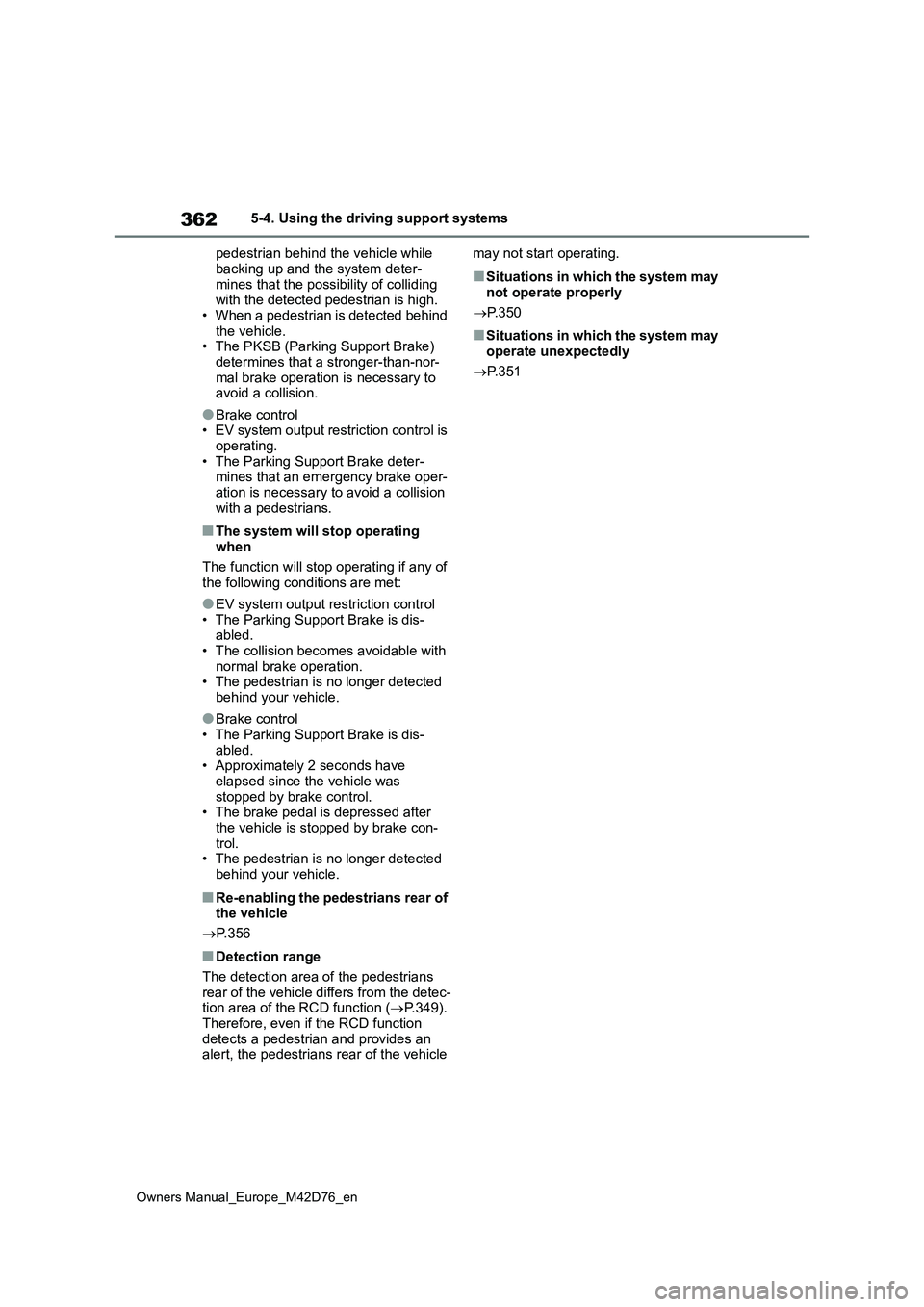
362
Owners Manual_Europe_M42D76_en
5-4. Using the driving support systems
pedestrian behind the vehicle while
backing up and the system deter- mines that the possibility of colliding with the detected pedestrian is high.
• When a pedestrian is detected behind the vehicle.• The PKSB (Parking Support Brake)
determines that a stronger-than-nor- mal brake operation is necessary to avoid a collision.
●Brake control• EV system output restriction control is
operating. • The Parking Support Brake deter-mines that an emergency brake oper-
ation is necessary to avoid a collision with a pedestrians.
■The system will stop operating when
The function will stop operating if any of the following conditions are met:
●EV system output restriction control• The Parking Support Brake is dis-abled.
• The collision becomes avoidable with normal brake operation.• The pedestrian is no longer detected
behind your vehicle.
●Brake control
• The Parking Support Brake is dis- abled.• Approximately 2 seconds have
elapsed since the vehicle was stopped by brake control.• The brake pedal is depressed after
the vehicle is stopped by brake con- trol.• The pedestrian is no longer detected
behind your vehicle.
■Re-enabling the pedestrians rear of the vehicle
P. 3 5 6
■Detection range
The detection area of the pedestrians rear of the vehicle differs from the detec-tion area of the RCD function ( P.349).
Therefore, even if the RCD function detects a pedestrian and provides an alert, the pedestrians rear of the vehicle
may not start operating.
■Situations in which the system may
not operate properly
P. 3 5 0
■Situations in which the system may operate unexpectedly
P. 3 5 1
Page 366 of 674
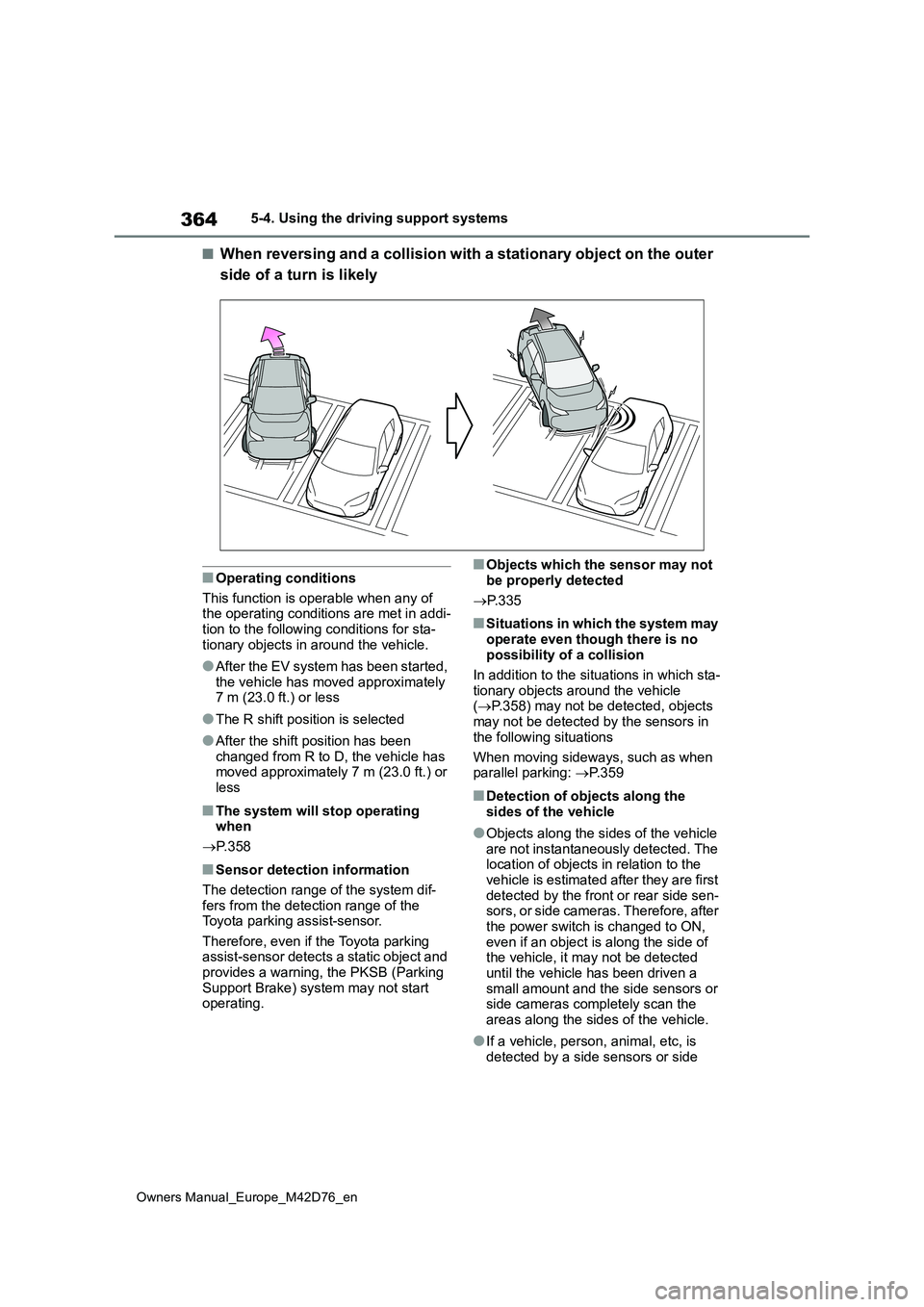
364
Owners Manual_Europe_M42D76_en
5-4. Using the driving support systems
■When reversing and a collision with a stationary object on the outer
side of a turn is likely
■Operating conditions
This function is operable when any of the operating conditions are met in addi-
tion to the following conditions for sta- tionary objects in around the vehicle.
●After the EV system has been started, the vehicle has moved approximately 7 m (23.0 ft.) or less
●The R shift position is selected
●After the shift position has been changed from R to D, the vehicle has moved approximately 7 m (23.0 ft.) or
less
■The system will stop operating when
P. 3 5 8
■Sensor detection information
The detection range of the system dif- fers from the detection range of the Toyota parking assist-sensor.
Therefore, even if the Toyota parking assist-sensor detects a static object and provides a warning, the PKSB (Parking
Support Brake) system may not start operating.
■Objects which the sensor may not be properly detected
P. 3 3 5
■Situations in which the system may
operate even though there is no possibility of a collision
In addition to the situations in which sta-
tionary objects around the vehicle ( P.358) may not be detected, objects may not be detected by the sensors in
the following situations
When moving sideways, such as when parallel parking: P.359
■Detection of objects along the
sides of the vehicle
●Objects along the sides of the vehicle
are not instantaneously detected. The location of objects in relation to the vehicle is estimated after they are first
detected by the front or rear side sen- sors, or side cameras. Therefore, after the power switch is changed to ON,
even if an object is along the side of the vehicle, it may not be detected until the vehicle has been driven a
small amount and the side sensors or side cameras completely scan the areas along the sides of the vehicle.
●If a vehicle, person, animal, etc, is detected by a side sensors or side
Page 370 of 674

368
Owners Manual_Europe_M42D76_en
5-4. Using the driving support systems
WARNING
• Be careful so that a necktie, scarf, or arm does not get caught. Keep
your upper body away from the steering wheel. Also, keep children away from the steering wheel.
• Long fingernails may be caught and when the steering wheel is rotating,
leading to injury.
• In an emergency, depress the
brake pedal to stop the vehicle, and then press the Advanced Park main switch to disable the system.
●Do not allow anyone to put their hands outside of a window while
this system is operating.
■Precautions for the cameras and
sensors
●Due to the characteristics of the camera lens, the position of and
distance to people and objects dis- played on the screen may differ from the actual situation. For details
on the following, refer to “Multime- dia owner’s manual”.
●Make sure to observe the precau-tions for using the Toyota parking assist-sensor ( P.348), otherwise
a sensor may not operate correctly, possibly leading to an accident.
●In situations such as the following, the sensors may not operate cor-rectly, possibly leading to an acci-
dent. Proceed carefully.
• When there is a parked vehicle next
to the target parking space, if the displayed target parking space is far from the actual target parking
space, a sensor may be mis- aligned. Have the vehicle inspected by any authorized Toyota retailer or
Toyota authorized repairer, or any reliable repairer.
• Do not install any accessories near the detection area of the sensors.
■To ensure correct operation of the Advanced Park
Observe the following precautions.
Failing to do so may result in the vehi- cle being unable to be driven safely and possibly leading to an accident.
●Do not use this system in situations such as the following:
• When in areas other than common parking spaces
• When the surface of the parking space is sand or gravel and is not
clearly defined with parking space lines
• When the parking space is not level, such as when on a slope or has differences in height
• Mechanical parking system
• Parking lot with a device which raises to contact the bottom of the vehicle
• When the road surface is frozen, slick, or covered with snow
• When it is extremely hot and the asphalt is melting
• When there is an object in front of the vehicle
• When there is an object between your vehicle and the target parking
spot or within the target parking spot (within the displayed blue box)
• When there is a gutter between your vehicle and the target parking space or within the target parking
spot (within the displayed blue box)
• When there is a hole or gutter in the
exit direction
• When in high pedestrian or vehicle
traffic areas
• When the parking space is in a
location that is difficult to park in (too narrow for your vehicle, etc.)